Planning a trip to Norway? Alongside the stunning scenery and rich history, don’t miss the chance to explore the country through its food. These 11 must-try and easy-to-find Norwegian favourites will give you a true taste of everyday life.
Trying a foreign country’s food is often one of the top benefits of going through the effort of travelling there. Norway is no different, and if you ever get the chance to visit the country, there are some foods you simply have to sample.

From the snappy bite of a classic pølse (a Norwegian hot dog) to the sweet, twisty temptation of a kanelsnurr (a Norwegian cinnamon bun) we’ve got your foodie itinerary covered.
So, whether you’re planning an actual trip or simply want to travel virtually by reading these lines, get cosy and join us on a journey of culinary discovery.
It would be fair to say that Norway is known more for its breathtaking landscapes than for its cuisine, but there are several local foods that are definitely worth a detour. Whatever your budget, our list will feature something for you.
1. Norwegian Brown Cheese (Brunost)
You may love it or hate it, but one thing’s for sure: no culinary journey through Norway is complete without tasting brunost, the iconic Norwegian brown cheese. It's a national obsession, a fridge staple in many homes, and a frequent topic of curious conversation among tourists.
First, a clarification. Despite its name, brunost isn’t technically a cheese. It’s made from whey, the liquid byproduct left over during cheesemaking. This whey is boiled down for hours until the milk sugars caramelise, giving the final product its distinctive brown colour, sweet-savoury flavour, and smooth, fudge-like texture.
The most common variety combines cow's and goat's milk, but goat-heavy versions have a tangier, more complex taste.
You’ll find brunost in every Norwegian supermarket, usually sold in rectangular blocks wrapped in waxy packaging. It’s not meant to be hacked into chunks—instead, Norwegians slice it very thinly using a cheese slicer (ostehøvel), which helps balance the rich, sweet flavour.
If you're not travelling with your own slicer, many shops also sell smaller, pre-sliced packets—similar to how ham or salami is packaged—making it easy to sample without the mess.
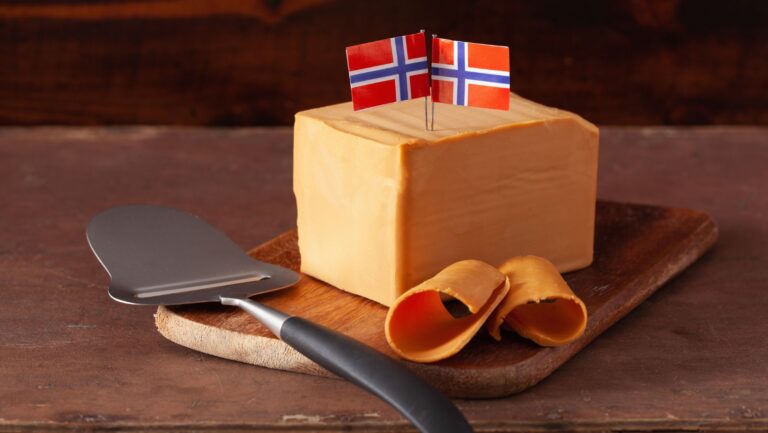
Brown cheese pops up in all kinds of places: melted into waffles (vafler), layered in sandwiches, or perched on crispbread.
Many coffee shops offer it as a filling for waffles or sveler (thick, spongy pancakes, more on these later), often paired with jam for a sweet-and-salty treat. It’s also a regular feature on hotel breakfast buffets, usually sitting alongside bread, butter, and other cheeses.
2. Cinnamon Bun (Kanelsnurr)
No trip to Norway is complete without sampling a cinnamon bun—or kanelsnurr, as they’re often called locally. This beloved baked treat is a staple of the Norwegian café scene and a cherished part of the country’s everyday food culture.
You might also hear it referred to as a skillingsbolle in Bergen or a kanelknute (cinnamon knot) elsewhere—names that hint at regional variations in shape, size and presentation.
While some come in neat spirals, others look like twisted knots of dough, but they all offer the same comforting aroma of cinnamon and sugar.
Unlike their American cousins, Norwegian cinnamon buns are typically less sweet, less gooey, and decidedly less buttery. The dough is often more bread-like than cake-like, giving the bun a light, chewy texture.
A sprinkle of pearl sugar on top adds a satisfying crunch, though some modern versions may be glazed for a bit of shine.
You’ll find kanelsnurrer in just about every bakery and café, often sitting temptingly by the counter alongside other classics like boller (sweet rolls with or without raisins).
Even convenience stores such as 7-Eleven and Narvesen stock them—particularly handy if you're craving a quick bite with your coffee on the go.
Whether enjoyed warm with a freshly brewed filter coffee or packed in a hiking bag for a sweet treat at the summit, the cinnamon bun is a humble yet iconic part of Norwegian food culture.
3. Cloudberries (Multe)
Known as molter/multer, these golden berries are a true Arctic treasure. What makes them special is that they are relatively rare, growing only in marshy terrains for a relatively short season.
You would be forgiven to assume based on looks alone that they taste something like a raspberry. They do not.
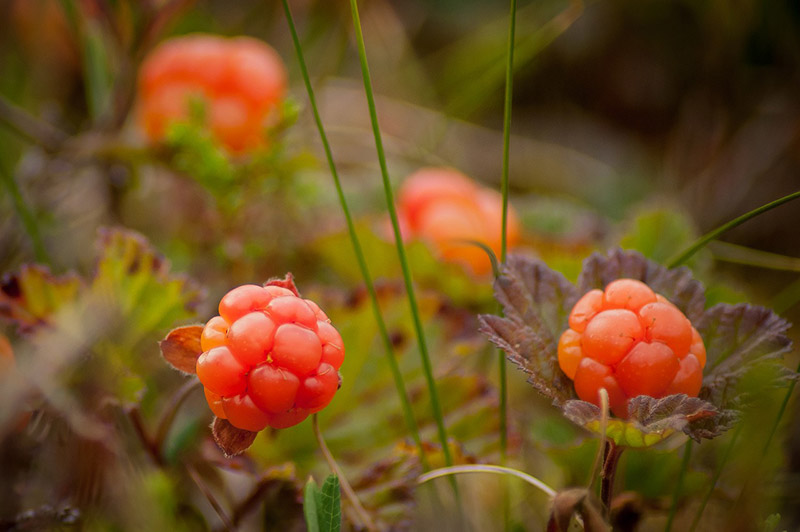
The flavour is difficult to describe. Sweet, yet tart, with a strong, difficult to identify note that comes from their high content in benzoic acid – a natural preservative.
You can buy fresh berries in shops when they are in season (August-September, depending on the area). The rest of the year, you can buy them frozen.
Where these berries truly shine though, is when they are used as an ingredient. I have fond memories of having an absolutely killer cloudberry-based cheesecake, so if you do see that on the menu somewhere, do give it a go.
At the breakfast table of your hotel, you may find cloudberry jam. Also highly recommended is cloudberry yoghurt, which is back on the shelves following a public outcry triggered by its removal from national dairy company Tine's product line.
Cloudberry liqueurs are also available on the market and offer a different and fun way to taste test these berries – and a nice souvenir or gift to get from the duty free shop on the way out of the country.
4. Norwegian Waffle (Vaffel)
Giving Norwegian waffles a try in Norway is both a must and super easy to do, given that they are basically everywhere.
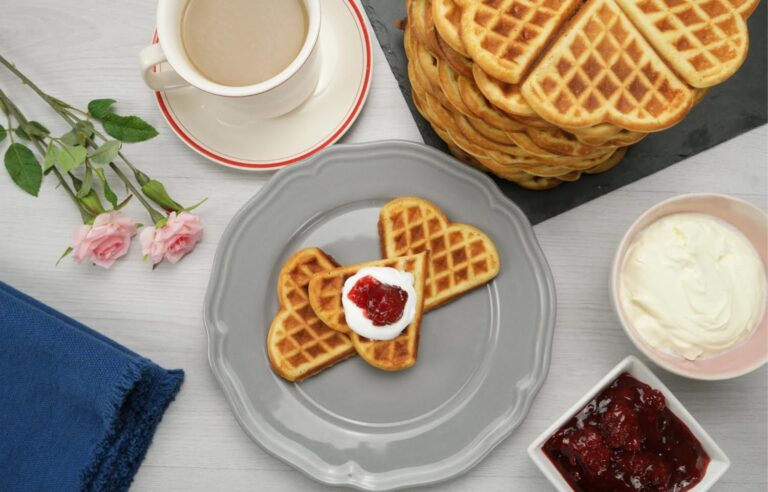
You can find it in cafes, ski lodges, some hotels, farmers’ markets and most Norwegian homes – should you get the chance to be invited.
Norwegian waffles are circular in shape and can be easily sectioned into heart-shaped portions that are usually topped with a garnish.
They are never doused with syrup since they are most commonly eaten by hand like a taco, and not from a plate with a fork and knife like a pancake.
They are thin and soft compared to their American and Belgian counterparts, and have a light vanilla aroma. Common toppings are rømme (Norwegian sour cream), jam, or brown cheese.
5. Shrimp Sandwich (Rekesmørbrød)
The humble yet elegant rekesmørbrød (a shrimp open sandwich) is a staple of Norwegian café culture and a firm lunchtime favourite. You’ll find it on menus everywhere from harbourside eateries to upmarket museum cafés.
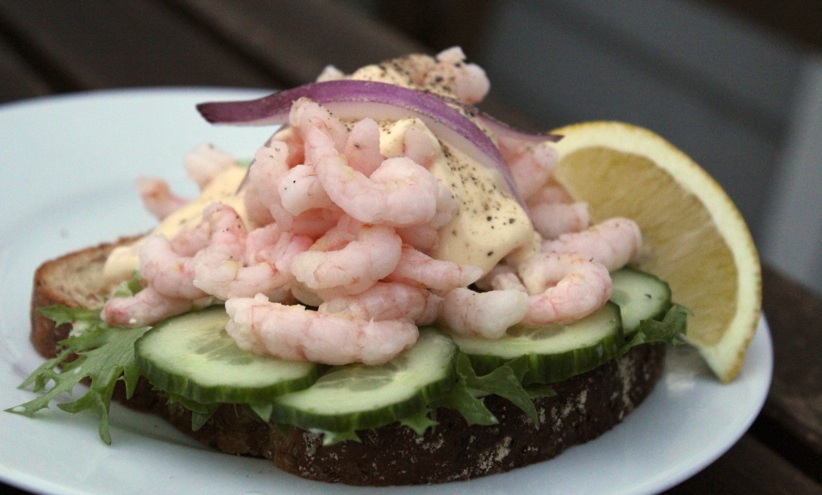
This classic dish brings together two essential elements of Scandinavian cuisine: the open-faced sandwich (smørbrød) and a love for cold-water seafood.
It typically starts with a thick slice of crusty white bread or rustic rye, generously buttered and then piled high with a generous mound of freshly peeled reker. These are small, sweet northern shrimps caught in Norway’s cold coastal waters.
These shrimps are nothing like the tropical prawns you may be used to: they’re smaller, more delicate, and prized for their clean, ocean-fresh taste.
The topping is usually finished with a dollop of mayonnaise, fresh cucumber slices, a scattering of fragrant dill, and a lemon wedge for a shot of citrus. Some variations include a boiled egg or a sprinkle of pepper, but the star is always the shrimp.
6. Norwegian Hot Dog (Pølse)
Call it Norway’s answer to fast food, but the humble pølse is much more than just a hot dog. It’s a full-on national obsession.
Found everywhere from petrol stations and ferry terminals to convenience stores and supermarket counters, the pølse is quick, cheap, and endlessly customisable. For many Norwegians, it’s the go-to snack on road trips, hikes, or even after a night out.
At first glance, it might not look wildly different from the classic American hot dog, though the sausage is usually milder in flavour and smoother in texture. Where things get distinctly Norwegian is in the serving style, and especially the toppings.
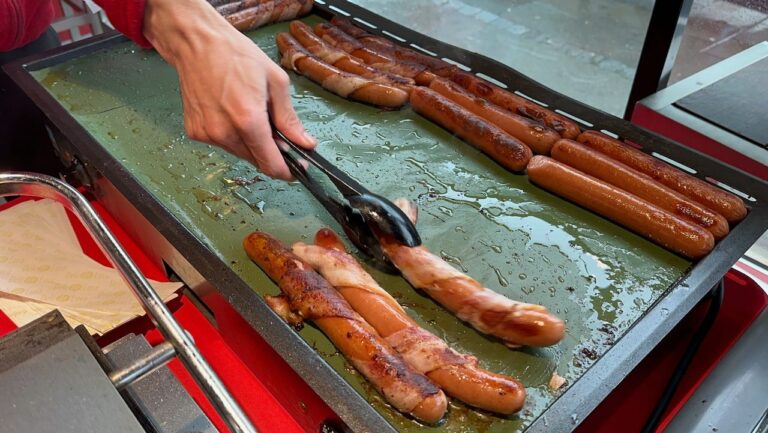
Sure, you can stick with ketchup and mustard, but why not try the more curious local favourites? Fried onions, raw onions, prawn salad (yes, really), and potato salad are among the possible options.
You can get your pølse served in a soft bun (brød), but to eat it like a local, ask for a lompe. The thin, slightly sweet flatbread made from potatoes is wrapped around the sausage like a tortilla.
Whether you're grabbing a bite at a gas station on the E6 or fuelling up between museums in Oslo, the pølse is an essential part of the Norwegian food experience—equal parts tradition, convenience, and comfort food.
7. Skolebrød
If you’re looking for a sweet treat that feels uniquely Norwegian, this cheerful pastry is an excellent place to start.
Soft, sweet, and just a little bit nostalgic, skolebrød (also known as skolebolle in parts of Norway) is a beloved pastry that you’ll spot in virtually every bakery and café across the country.
Whether you're grabbing a coffee in Oslo or stopping at a roadside kiosk in the fjords, chances are you’ll see this cheerful bun staring back at you from behind the glass.
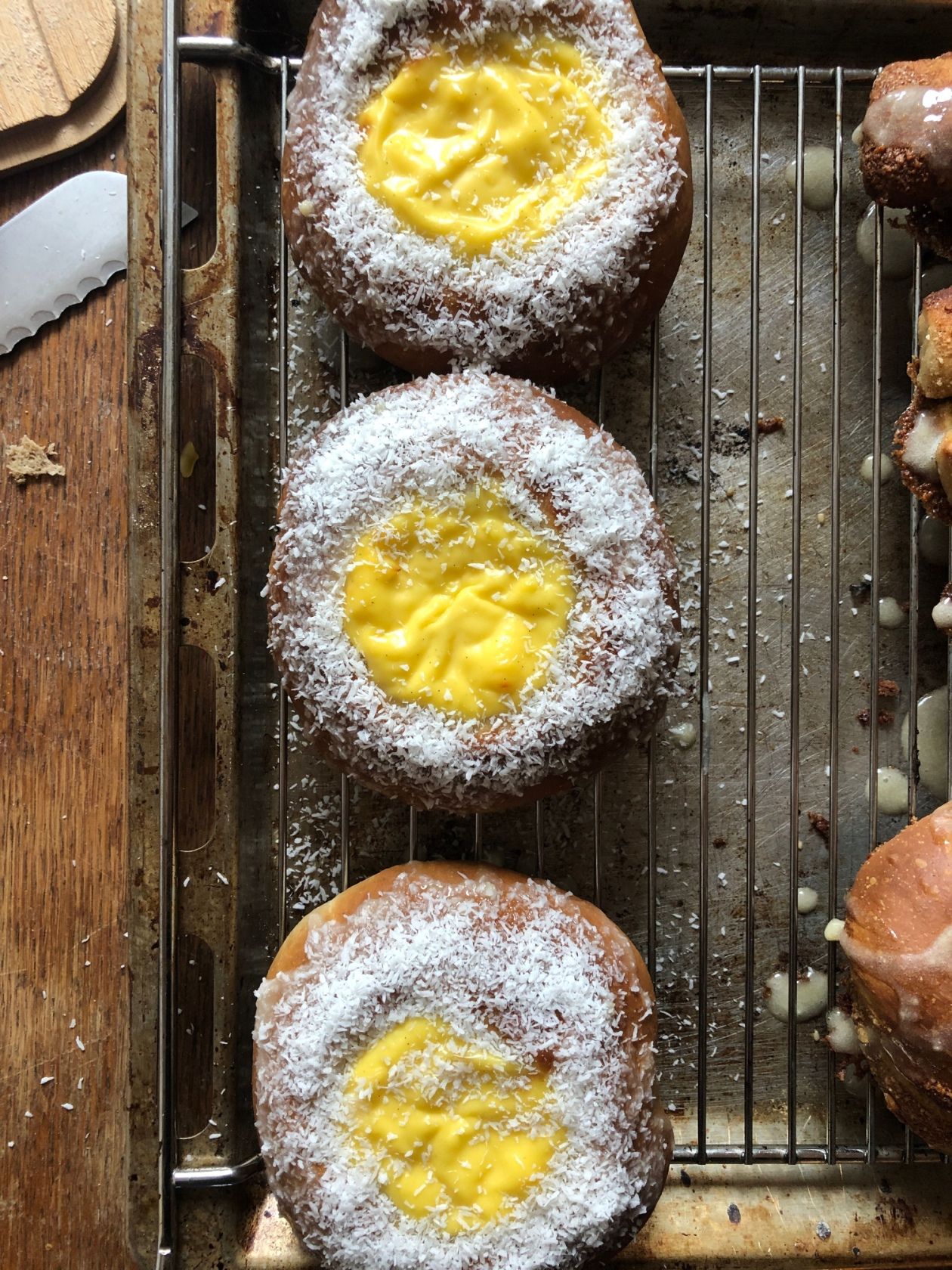
The name translates to “school bread” for good reason. It became popular in the 1950s when it was commonly packed into children's school lunches or sold at school bake sales.
However, although it may look like an old-fashioned classic, it’s a relatively modern addition to the Norwegian baking tradition.
The skolebrød itself is a soft, cardamom-spiced yeast bun filled with a generous dollop of creamy vanilla custard in the centre. After baking, it’s topped with a ring of white icing and rolled in desiccated coconut, giving it a distinctive snowy fringe.
The texture is somewhere between a sweet roll and a doughnut. It's light yet satisfying, and often enjoyed as a weekend treat together with coffee. It's also a popular item during road trips and at petrol station bakeries.
In recent years, it's even sparked some friendly debate. The skolebrødkrigen (school bread war) is all about whether the treat should be considered a cake or a bun. Either way, it's delicious.
8. Norwegian Fish Soup (Fiskesuppe)
If you are at all a seafood lover, you must try Norwegian fish soup. It generally comes in two types: a creamy, velvety white soup and a rich, tomato-based broth.
In both cases, fish stock is the foundation, and chunks of fish and seafood are the main attraction (usually cod, salmon and shrimp). Vegetables such as potatoes, carrots and leeks are also commonly used.
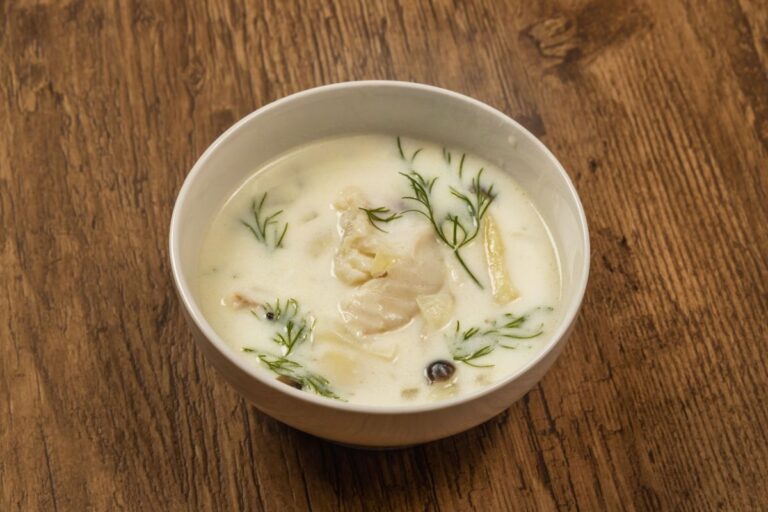
Norwegian fish soup is one of those dishes that can be found both in simple cafes and fancy restaurants. Every establishment has their own version of it, so you can try it multiple times and experience something new every time.
9. Svele
Soft, fluffy, and slightly sweet, svele is Norway’s answer to the American pancake, although it has its own unique identity and deeply local charm.
Made from a batter of flour, eggs, milk, sugar, and baking powder, sveler are cooked on a hot griddle or frying pan until golden brown on both sides. The result is a thick, spongy pancake with a comforting texture that makes it perfect for grabbing on the go.
What really sets svele apart is how it’s served. Instead of being stacked high on a plate with syrup and cutlery, Norwegian sveler are often eaten folded in half, held in one hand like a warm, edible envelope.
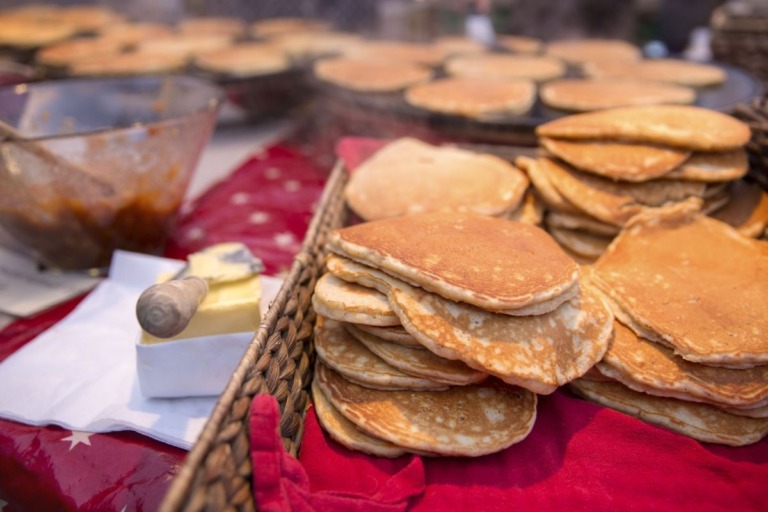
The most traditional topping is a simple but satisfying mixture of butter and sugar, though brown cheese, jam, and sour cream are also common. You’ll find sveler in cafés and ferry kiosks all along Norway’s rugged western coast, especially in the region around Ålesund and Møre og Romsdal.
In fact, for many Norwegians, svele and ferry rides go hand in hand. Grabbing a warm pancake while watching the fjords drift by is a small but memorable part of life in this part of the country.
10. Reindeer Stew (Reinsdyrgryte)
In the mood for something really Norwegian? It’s hard to get more authentic Instagram-fodder than reindeer stew.
This rich, slow-cooked stew, mixes lean gamey reindeer meat with a blend of root vegetables, mushrooms, and a mix of herbs. Some versions include a splash of red wine or juniper berries.
It is often served with flatbrød (crispy flat bread) and lingonberry jam. Just like fiskesuppe, you can try reindeer stew at several different establishments and feel like you’re eating a different dish every time.

The dish is a comforting, heartwarming delight, especially on chilly Norwegian evenings. Whether tried in a cosy mountain cabin or a local restaurant, a bowl of reinsdyrgryte is a must for those looking to savour the authentic, rustic flavours of Norway's culinary heritage.
11. Lefse
Lefse is one of those Norwegian words that’s hard to translate. That's not because it’s complicated, but because it’s so beloved in its own right.
Especially among Norwegian-Americans, lefse has taken on an almost legendary status, passed down through generations as a symbol of heritage and home baking.
At its core, lefse is a soft, pliable flatbread made from a simple mix of potatoes, flour, butter, and milk. It’s rolled thin and cooked on a griddle until golden-brown spots appear, much like a tortilla. The flavour is mild and comforting, with just a hint of buttery richness.
What makes lefse special is how it's served. The classic version is simply spread with butter and sprinkled with sugar before being rolled up into a log, making it perfect for enjoying with a cup of coffee or as a sweet midday snack.

That said, its neutral taste makes it incredibly versatile. Some versions are filled with cinnamon, jam, or even savoury ingredients like cured meats or cheese.
You’ll find lefse packaged in grocery stores, wrapped and ready to go in cafés, or even stacked in cafeterias at train stations, ferries, and hospitals. It’s a common treat to take on a journey: soft, satisfying, and nostalgic for many Norwegians.
While some bakeries still make fresh lefse by hand, most Norwegians buy the mass-produced versions from supermarkets, which are perfectly good for a quick snack.
If you’re lucky enough to come across a homemade one at a Christmas market or country café, don’t hesitate. It’s lefse at its best.
Michelin-Starred Restaurants
Okay, this is technically not a dish, but did you know that Norway boasts no fewer than 17 Michelin-starred restaurants?
We felt we had to include them because so far, this list has consisted of low to mid-range options that don’t give the entire Norwegian culinary picture.
So, if money is no concern for you, here is a perfect occasion to try the absolute best of what Norway’s gourmet scene has to offer. Expect locally sourced ingredients crafted into exquisite culinary creations and thoughtfully paired with exceptional wines.
Also expect an eye-watering bill at the end. If you can afford it, an evening at one of Norway’s Michelin-starred establishments is an experience to remember.
Whether you’re sampling brown cheese at breakfast, biting into a fresh cinnamon bun, or savouring a sweet slice of lefse, these iconic Norwegian foods offer a delicious glimpse into the country’s culture and everyday life.
What's your favourite food item to try in Norway? Let us know down in the comments.


One of the foods I was really taken by was “fenelår” and “lamb rolle”. These two item aren’t available in North America.
Hi there Asma Khan,
I’m a Norwegian transplanted in Oregon,USA. ‘lamb rolle’ is not the same as `fena lår`. Fena lår is a dried and cured leg of lamb. Lamb rolle is a hand made roll of slices of lamb along with spices and sewn together with needle and cotton yarn. Yes, they are available in N.USA as well!!!
I love all Norwegian food especially the brown cheese I will miss it when I return home to the U.K. but can’t seem to face eating reindeer.
Coffee is great, tea a no still have to get my t bags from the U.K. Lipton yellow teas is so bland.
Please give me some names of these supermaarkets
I’ve lived in North Dakota/Minnesota for roughly seven years, and I know lefse was typically a food served at Christmas time/around the holidays.
Hi Crystal,
I’m from Norway but have lived in USA over 50 yrs. FYI, did you know that there are over 50 different lefsa recipes in Norway’s cook books? Potato lefse are for the most -used as a ‘hot dog’ roll. Also lefse is served ANY TIME of the year you might want to indulge! If you are interested, email me and I will offer some recepies!
scrimp sandwich is must, but on white bread,
with white wine, and du glemte røkelaks på et rundstykke
Hi David. I was introduced to brown cheese as a 3 yr. old child living with my maternal grandparents, both came to the USA in the 1800s and brought with them things they knew we had to learn to be good Norskies!! Christmas meant Krumkake and more lease, as well as Kransekake. Yes, also Lutekiske, but that was not for me! The sweet rolls you mention really look delicious, and I will look for the recipe for sure!! Thank you for another “trip to Norway”! Pat Sallberg
Hi Pat from another ‘fellow Norskie’!
I came to Oregon in 1957.
Now, I see you might be looking for a recipe for Shillings boller or as you said-sweet rolls… if you’re still interested, email me – I have a good one to share.
Might I correct you – it’s not called LUTEKISKE- it’s called LUTEFISK and it’s an ‘grown-to-love’ taste and my husband can not stand it either! Ta,ta Randi.
Hi again, David. I see where my iMac replaces words in my text messages! I.E. lease was lefse and lutekiske was Lutefiske. Hope these come through correctly this time.